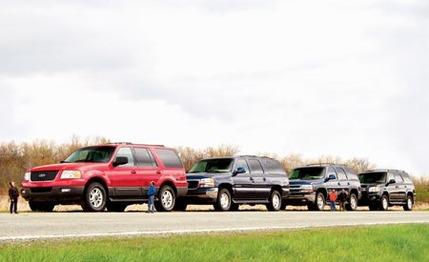
 Comparison Tests
Comparison Tests
Most mere mortals experience a humbling effect when gazing at the grandeur of the Rocky Mountains, or across the vastness of the Pacific Ocean, or into the infinite depth of the cosmos. We gain perspective and feel puny, insignificant. It's good periodic maintenance for the soul to take such time-outs now and again.
The rest of the time, many Americans like to make other folks feel small. This is good for the ego, and it's ever so easily accomplished from the driver's throne of one of these four, ahem, "full-size" sport-utility vehicles. Climb aboard one of these brutes, and you're looking down on practically every other implement of personal transportation. That's their charm, their allure.
Whatever motivates their sales, just under 850,000 full-size SUVs lumbered out of showrooms and into suburbia (and urbia for that matter) last year - that's roughly 10 percent of the so-called light trucks that now account for half of all vehicles sold. That's a lot of automotive belittlement. Or a lot of large nuclear families hauling travel-trailers out to wilderness vacations, if you buy the advertising.
Chevrolet arguably pioneered the segment with its 1935 EB-series Suburban Carryall, an all-steel eight-passenger station wagon built on a half-ton truck chassis. The Suburban has dominated the market niche it created, outliving such worthy rivals as the International Travelall and Jeep Wagoneer. More recently it has sired a family of variants that now include the GMC Yukon/Denali XL, the shortened Chevy Tahoe and GMC Yukon/Denali, the upscale Cadillac Escalade (coming soon in stretched Escalade ESV trim), and even the highly altered Hummer H2. Together, the Suburban and its offspring snag 63 percent of the full-size-SUV market.
The current generation of this GMT800 platform was renewed two years ago and promptly earned top honors here during a comparison-test adventure through Arizona's Canyon de Chelly ("Call of the Canyon," July 2000), with a three-quarter-ton Chevy Suburban finishing first and a GMC Yukon SLT second. Cross-town rival Ford finished third with its Expedition, and an Excursion came in fourth.
Since then, the Expedition has undergone a thorough makeover. The 2003 model rides on an all-new frame that no longer has to hump over a live rear axle in back. This lowered frame leaves room for adult-size third-row seats that fold flat into the floor, and the independent rear suspension lowers unsprung weight, which tends to improve ride and handling.
Also seeking to siphon off some of GM's juicy truck profits is Toyota, which ute-icized its full-size Tundra pickup into the Sequoia for 2001. Powered by a 4.7-liter four-cam V-8, this relative newcomer adheres strictly to the American-big-ute formula for size and capability - it's even assembled in Indiana.
The commercial-grade, destroyer-class Excursion has not been modified substantially since our Arizona outing, so it was excused. The other utes in the jumbo class are low-volume luxury models costing well above our $45,000 price ceiling.
We suspect that high-up style, crash invincibility, and the potential to intimidate fellow motorists are the qualities that really sell jumbo utes, but these traits are difficult for us to quantify, and you know how we love numbers. Besides, they're politically incorrect for an owner to admit to considering. In an admitted act of desperation, we decided to assess these trucks on the characteristics that owners claim they need (that is, the stuff they saw the trucks doing in the advertising): light off-roading, heavy towing, and comfy cruising for seven or eight passengers and stuff. Sure, the results may be irrelevant to folks making the purchase decision, but maybe what follows will help them make a more convincing and socially acceptable defense of their truck choice when gabbing around the water cooler.